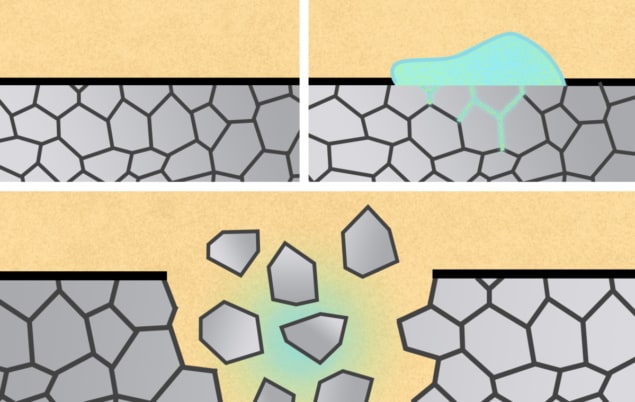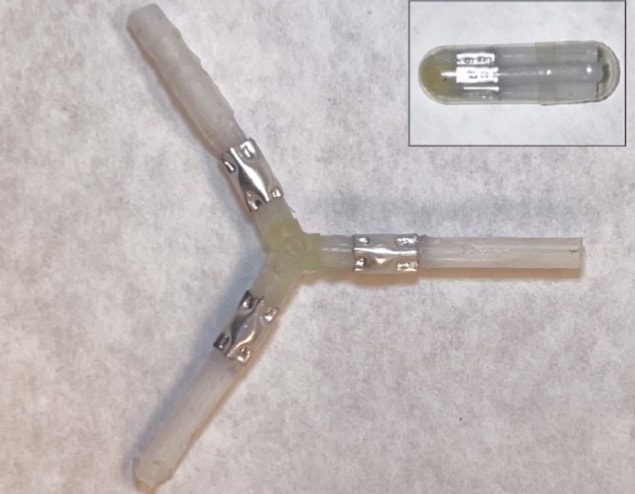
Liquid metals are used in everything from thermostats and barometers to wearable devices. Scientists say that these metals may also eliminate some surgical or endoscopic procedures – by dissolving implantable devices made from solid metals on command.
“Because of their excellent mechanical strength, metals are very useful for making medical devices that need to resist large forces, like long-term drug delivery systems. For these kinds of devices to be broadly accessible to patients, we also need non-invasive methods of removing them from the body,” says Vivian Feig, a postdoctoral research fellow at MIT and Brigham and Women’s Hospital.
Feig is the lead author on a recent study demonstrating how gallium alloys, which are in liquid state at body temperature, can break down aluminium-based devices. In the future, the researchers hope that they can trigger more clinically relevant metals, such as titanium, to break down upon exposure to gallium.
Intentional metal failure
Liquid metal embrittlement, a phenomenon that leads to fractures in metal, is the key to the researchers’ method for dissolving metal implantable devices. “Liquid metal embrittlement is a fairly well-studied phenomenon that has been historically treated as a failure mechanism meant to be avoided,” Feig explains.
But Feig and the team were looking for ways to build medical devices out of tough, durable materials that can also be prompted to break down after use. Most actively triggerable materials to date have been made from polymers, which aren’t as strong as metals. What if, the researchers reasoned, a liquid metal like gallium could be used as a biocompatible trigger “that leverages embrittlement in a productive manner to address a clinically-important challenge”.
The result: repurposing an alloy of gallium called eutectic gallium indium (EGaIn).
Scientists have already explored EGaIn for a variety of applications in biomedicine, energy and flexible electronics. Feig and her team tested whether EGaIn could be formulated for targeted breakdown of aluminium in the body. In their recent study, described in Advanced Materials, they performed experiments to initiate embrittlement in EGaIn and control its breakdown. They also demonstrated potential biomedical uses of EGaIn and performed some biocompatibility studies.

The researchers’ functional formulation of EGaIn weakens aluminium by diffusing through a metal’s grain boundaries – border lines between crystals that make up the metal – which causes pieces of the metal to break off. EGaIn also prevents aluminium from forming a protective oxide layer on its surface, which increases the aluminium’s exposure to water and enhances its degradation.
Aluminium devices painted with EGaIn disintegrate within minutes, experiments showed. The researchers also created nanoparticles and microparticles of gallium-indium and demonstrated that these particles, suspended in fluid, could also break down aluminium structures.
Feig says that EGaIn could be painted onto staples used to hold skin together, causing the staples to disintegrate on-demand and preventing damage that can occur during procedures to remove them. EGaIn could also be used to break down stents implanted in oesophageal tissue. To date, stents are left in the body permanently or removed endoscopically.

Dissolvable implant cools nerves to provide drug-free pain relief
Next, the researchers will perform extensive biocompatibility testing, exploring applications for EGaIn in different physiological environments and studying how different metals respond to EGaIn. The team is also working to address changes in liquid metal performance arising when metal surfaces are coated by proteins and other endogenous materials.
“We hope this work can inspire others to think about failure mechanisms like embrittlement in a different way – as processes that can actually be beneficial for addressing certain biomedical challenges,” Feig says. “Now, we are delving deeper into understanding how we can make metals more susceptible to embrittlement. This knowledge will help us apply our work to a wider range of clinically relevant metals, beyond aluminium.”
- SEO Powered Content & PR Distribution. Get Amplified Today.
- Platoblockchain. Web3 Metaverse Intelligence. Knowledge Amplified. Access Here.
- Source: https://physicsworld.com/a/liquid-metal-disintegrates-implanted-medical-devices-on-demand/



